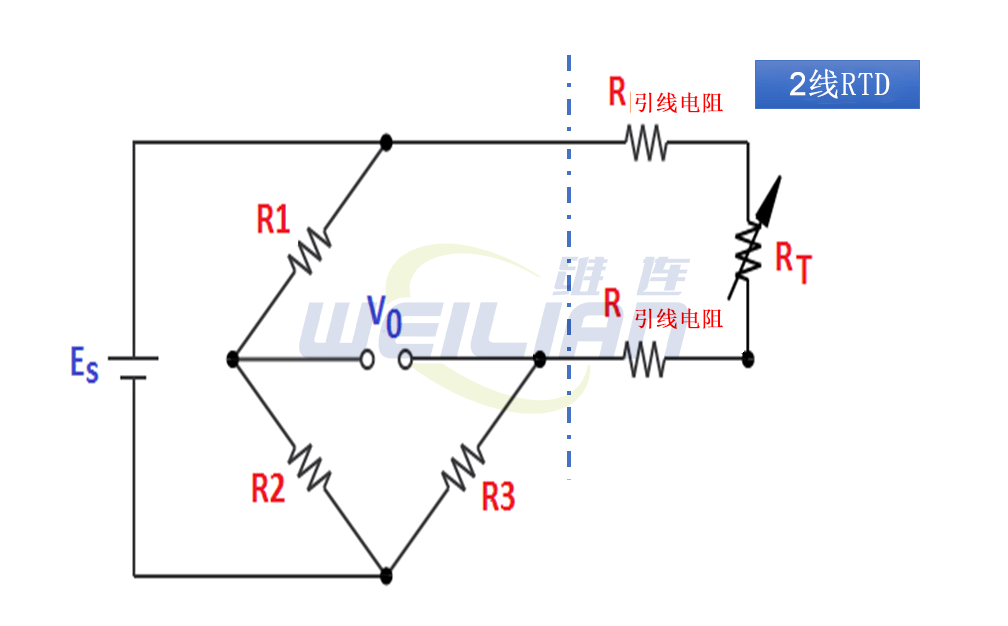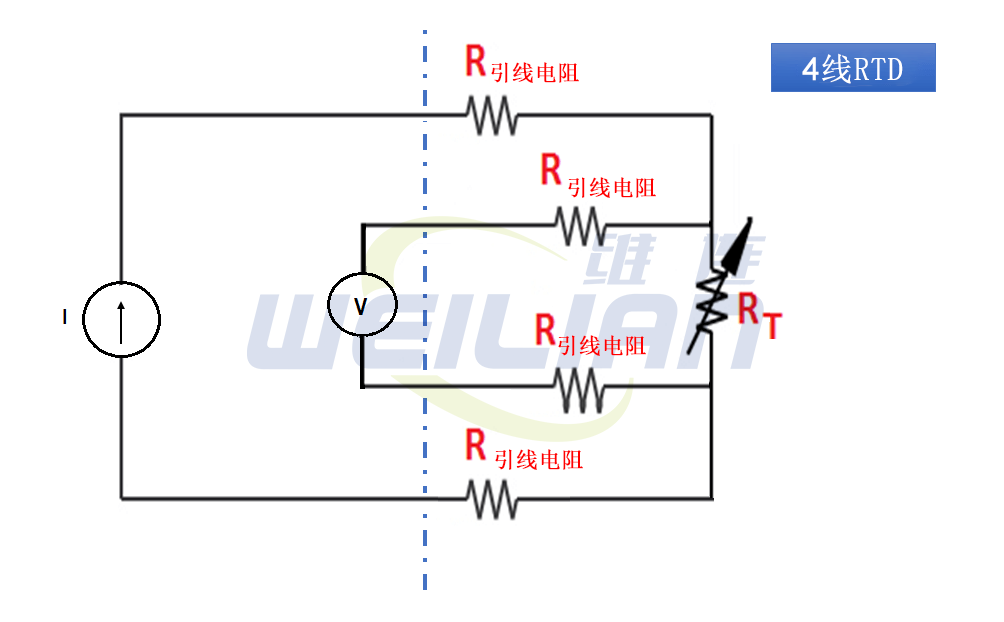
Why 4 line RTD temperature sensors measurement accuracy is better than 2 and 3 line RTD?
Thermocouple is used to measure temperature, but measurement is based on the temperature difference of the hot and cold end. The cold end temperature can be changed according to the surrounding environment conditions. In order to offset the impact of the cold end temperature, the transmitter provides cold end compensation to obtain an absolute temperature.
In contrast, RTD measures the absolute temperature value. In the case of measuring low -range temperature, the RTD temperature sensor is the first choice.
One of the main errors in measurement is the bidding resistance error. We use the triple cable (3 cores) to connect the 3 -line RTD temperature sensor and the corresponding transmitter. These cable resistors are called lead resistance.
The transmitter and the RTD temperature sensor are installed in different positions. The measuring error increases with the distance between the position between the transmitter and the RTD temperature sensor.
2 line RTD temperature sensor
The radio resistance is the resistance of the RTD temperature sensor, so the measurement error is added. The circuit diagram of the 2 line RTD temperature sensor is shown below.

● R1, R2, R3 is the resistance of Whist Tongxiao
● R DRed is the resistance of the specific attraction
● R T is the resistance of the RTD temperature sensor
Under the condition of bridge balance
(R 1 /R 2) = (R X) /(R 3) < /p>
r x = (r 1 /r 2) (r 3)
Here RX is the sum of the R T and two binding resistors.
It can be clearly seen from the above that the lead resistance will introduce errors in measurement.
Example
The RTD model is PT 100. The temperature coefficient of the RTD temperature sensor is 0.00385.
Case 1:
Suppose we measure the resistance of the RTD temperature sensor on the terminal of the 2 -line RTD temperature sensor without any lead.
Suppose the temperature is 100 degrees Celsius.
The resistance of the temperature sensor is 138.5 ω
In this case, the measured resistance displays the correct temperature reading.
Case 2:
In actual applications, we use cables to connect RTD to transmitters. The cable resistance is called the lead resistance, which will increase the total resistance.
We use 2 lead to connect to RTD and transmitter. If each lead resistance is 1 ω
So total resistance = RTD + (2 X Ding Ring resistance)
Total resistance = (138.5 + (2 x 1)) = 140.5 ω
In this case, the temperature according to the total resistance value is 105.19 degrees Celsius. Therefore, the lead resistance introduced a measuring error of 5.19 degrees Celsius.
Use the RTD calculator to easily calculate. Don't forget to update the temperature coefficient value according to the example.
3 line RTD
3 Line RTD is more accurate than measuring measurement. 3 Line RTD is mainly used for the temperature measurement of industrial applications.
Let's understand why the 3 -line RTD reads more accurate than the 2 -line RTD reading. The circuit diagram of the 3 line RTD is shown below.

Simply put, the equation of Whist Tong Bridge is as follows
(R 1 /R 2) = (R T +R Drial resistance) /(R 3 +R Drial resistance) < /p>
In the equivalence above, the molecules and denominator of the right part of the equal formula increase the R Ding wire, so this ratio will not be affected by the lead resistance. It must be noted that the length of the two leads is similar. Therefore, Drawing Compensation can be completed through 3 -line RTD.
Under the bridge balance conditions.
R T + R Drial resistance = R 3 + R Drial resistance
r t = r 3
In the 3 -line RTD, the lead resistance R leading resistance will offset each other with the help of the third lead. As a result, measurement will not be affected by the lead resistance.
Pay attention to the similar resistance of the two leads. Therefore, the lead compensation can be accurately conducted through the 3 -line RTD.
Only when all the binding resistors are equal, the compensation of the lead resistance is accurate. Otherwise, the temperature measurement will occur due to the non -matching of the leading resistance.
4 line RTD
4 line RTD is used to completely eliminate measurement errors caused by wire resistors.
In the 2 -line RTD and 3 -line RTD, the temperature measurement will be affected due to the changes in the RTD resistance due to the lead. In these two cases, the measured temperature is based on resistance. So we got a mistake. In the 2 -line RTD, the error value is high, and in the 3 -line RTD, the error value is very small.
Why is the 4 -line RTD better?
But in the 4 -line RTD, we do not measure the temperature according to the resistance. We use the two leads of Hengliu Source and the 4 -line RTD. We measured the voltage drop on the other two other leads of RTD.
According to Ohm's Law, v = IR
The current value here is constant (very small). The voltage will be generated according to the change of the resistor, and the change of the resistance depends on the measured temperature.
This is why the 4 -line RTD is more accurate than the 2 or 3 line RTD, because the voltage -based signal rather than the resistance for temperature measurement.
The circuit diagram of the4 line RTD is shown below.

The 4 -line RTD is used to measure the temperature in the trade transfer instrument. The test laboratory requires accurate temperature reading.
3 cable RTD canceled the lead resistance, but it does not deal with the problem of not matching the lead resistance. The 4 -line RTD is used to completely eliminate the error that is not matched or even causes.
4 -line RTD system is more expensive than the 2 -line and 3 -line RTD system, but the most suitable application that requires high accuracy.
The only disadvantage of4 line RTD is that it may introduce very, very small measurement errors due to self -heating (because constant current flows over RTD). Regularly calibrate the transmitter to verify the measurement accuracy.
Conclusion
● Due to the lead resistance, the 2 -line RTD will introduce more errors in the measurement. If the transmitter is installed near the RTD, the 2 -line RTD is suitable.
● 3 line RTD is suitable for industrial applications. The lead compensation can be performed in the 3 -wire temperature measurement system. The error caused by the lead resistance is completely eliminated, but the non -matching of the lead resistance will cause measurement errors.
● 4 -line RTD is the best choice for applications that require precise temperature measurement.

